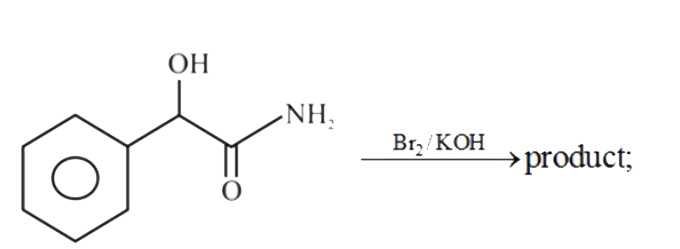Intermediate in hoffmann bromide reaction ?
To determine the intermediate in the Hoffmann bromamide degradation reaction, we can follow these steps:
Step 1: Understand the Reaction
The Hoffmann bromamide degradation involves the conversion of a primary amide (RCO NH2) into a primary amine (RNH2) using bromine (Br2) and sodium hydroxide (NaOH).
Hint: Recall that the reaction involves the transformation of an amide to an amine.
Step 2: Identify the Reactants and Products
The reactants are:
- RCO NH2 (primary amide)
- Br2 (bromine)
- NaOH (sodium hydroxide)
The product is:
- RNH2 (primary amine)
Hint: Write down the chemical structures of the reactants and products to visualize the transformation.
Step 3: Determine the Mechanism
In the Hoffmann bromamide degradation, the reaction proceeds through the formation of an intermediate. The mechanism typically involves the formation of an isocyanate intermediate.
Hint: Consider the steps that involve the formation of a reactive intermediate before reaching the final product.
Step 4: Identify the Intermediate
The intermediate formed in this reaction is RN=C=O, which is known as an isocyanate. This compound is formed after the bromination and subsequent hydrolysis of the amide.
Hint: Remember that the intermediate is often a transient species that can quickly convert to the final product.
Step 5: Conclusion
The intermediate in the Hoffmann bromamide degradation reaction is RN=C=O (isocyanate), which then hydrolyzes to form the primary amine (RNH2).
Final Answer: The intermediate in the Hoffmann bromamide degradation reaction is RN=C=O (isocyanate).
The Hoffmann bromamide degradation involves the conversion of a primary amide (RCO NH2) into a primary amine (RNH2) using bromine (Br2) and sodium hydroxide (NaOH).
The reactants are:
- RCO NH2 (primary amide)
- Br2 (bromine)
- NaOH (sodium hydroxide)
- RNH2 (primary amine)
In the Hoffmann bromamide degradation, the reaction proceeds through the formation of an intermediate. The mechanism typically involves the formation of an isocyanate intermediate.
The intermediate formed in this reaction is RN=C=O, which is known as an isocyanate. This compound is formed after the bromination and subsequent hydrolysis of the amide.
The intermediate in the Hoffmann bromamide degradation reaction is RN=C=O (isocyanate), which then hydrolyzes to form the primary amine (RNH2).
Topper's Solved these Questions
Similar Questions
Knowledge Check
Which of the following will not show Hoffmann bromide reaction?
A B
B C
C D
D
Which of the following will not give Hoffmann bromaminde reaction ?
ACH3−O∣∣C−NH2BPh−O∣∣C−NH2CCH3−O∣∣C−NH−BrDPh−O∣∣C−NH−Ph
Product of this Hoffmann bromamide reaction is :APh−O∣∣C−CH3BPh - CHOC DPh−CH2−NH2
DPh−CH2−NH2
Write short note on the following :
(i) Carbylamine reaction
(ii) Diazotization
(iii) Hoffmann's bromide reaction
(iv) Coupling reaction
(v) Ammonolysis
View SolutionWrite structures and IUPAC names of
(i) the amide which gives propanamine by Hoffmann bromamide reaction.
(ii) the amine produced by the Hoffmann degradation of benzamide.
View Solution
Product of this Hoffmann bromamide reaction is
View SolutionBenzamide is subjected to Hoffmann's bromamide reaction, the product formed is
View SolutionWhich of the following compounds will not give Hoffmann's hypobromite reaction ?
View Solution
